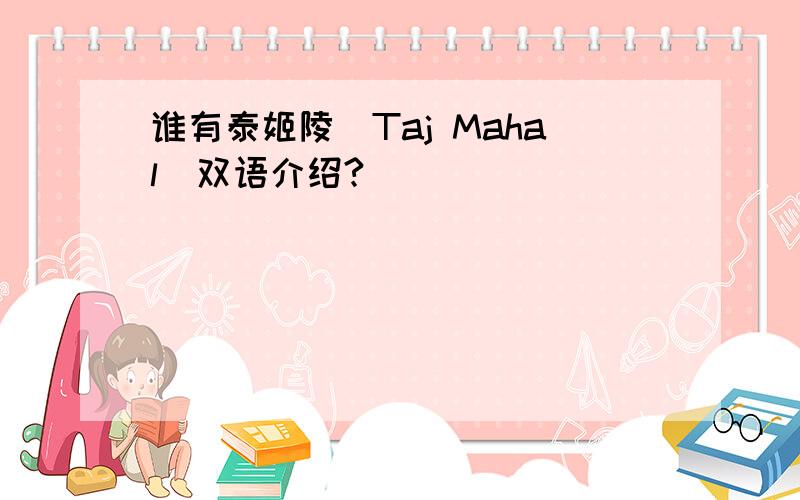谁有泰姬陵(Taj Mahal)双语介绍?
来源:学生作业帮助网 编辑:作业帮 时间:2024/04/29 00:40:08

谁有泰姬陵(Taj Mahal)双语介绍?
谁有泰姬陵(Taj Mahal)双语介绍?
谁有泰姬陵(Taj Mahal)双语介绍?
泰姬陵
中文名称: 泰姬陵
英文名称: Taj Mahal
国家: 印度
所属洲: 亚洲
泰姬陵(印地语: ताज महल 波斯语,乌尔都语: تاج محل ),全称为“泰吉·玛哈尔陵”,又译泰姬玛哈,是印度知名度最高的古迹之一,在今印度距新德里200多公里外的北方邦的阿格拉 (Agra)城内,亚穆纳河右侧.是莫卧儿王朝第5代皇帝沙贾汗为了纪念他已故皇后阿姬曼·芭奴(ممتاز محل)而建立的陵墓,被誉为“完美建筑”.它由殿堂、钟楼、尖塔、水池等构成,全部用纯白色大理石建筑,用玻璃、玛瑙镶嵌,绚丽夺目.有极高的艺术价值.是伊斯兰教建筑中的代表作.2007年7月7日,成为世界新七大奇迹之一.
概况介绍
1983年根据文化遗产评选标准C (I) 被列入《世界遗产目录》.评为遗产的报告:世界遗产委员会第7届会议报告.是北京时间2007年7月8日凌晨公布的“新七大奇迹”之一.
从数不清的照片中使人非常熟悉的泰姬陵的外形被作为饭店的标志、酸辣酱和调味品的商标,实际上它被用在随便什么地方,人们看到立刻就想到是印度的地方.尽管如此,很少有人看了泰姬陵感到失望的.
泰姬陵百看不厌,它仍旧能使人惊讶.它在一天里不同的时间和不同的自然光线中显现出不同的特色.虽然它是一座陵墓,可它却没有通常陵墓所有的冷寂.相反你感到它似乎在天地之间浮动.它的和谐对称、花园和水中倒影融合在一起创造了令无数参观者惊叹不已的奇迹.估计有2万名工匠参与了泰姬陵的建造,历时22年才完成.据说一位法国人和一位威尼斯人参与了工程的部分工作.至今没有一位建筑师被记录肯定参与了陵墓的建造——这对这个建筑物是很适宜的,因为建造它的本意在于让人们只记住在陵墓里的人.
朝霞升起时分,初升的一轮红日伴着朱木拿河袅袅的晨雾,仿佛要将泰姬陵从睡梦中唤醒,此时的它显得静静的.中午时分,泰姬陵头顶蓝天白云,脚踏碧水绿树,在南亚一向耀眼的阳光映衬下,更出落得玲珑剔透,光彩夺目.傍晚,泰姬陵迎来了它一天中最妩媚的时刻,斜阳夕照下,白色的泰姬陵开始从灰黄、金黄,逐渐变成粉红、暗红、淡青色,随着月亮的冉冉升起,最终回归成银白色.在月色朦胧中,泰姬陵显得格外高雅别致和皎洁迷人,犹如美人泰姬在含情沉思.据称,泰姬陵最美丽的时候,是朗月当空的夜晚.白色的大理石陵寝,在月光映照下会发出淡淡的紫色,清雅出尘,美得仿佛下凡的仙女.
建筑历史
泰姬陵于1631年(另一资料:1632年)开始动工,历时22年(另一资料:18年),每天动用2万役工.除了汇集全印度最好的建筑师和工匠,还聘请了中东、伊期兰地区的建筑师和工匠,更是耗竭了国库(共耗费4000万卢比),这导致莫卧尔王朝的衰落.沙·贾汗国王本原计划在河对面再为自己造一个一模一样的黑色陵墓,中间用半边白色、半边黑色的大理石桥连接,与爱妃相对而眠.但泰姬陵刚完工不久,其子奥朗则布(Aurangzeb)弑兄杀弟篡位成功,沙·贾汗国王本人也被囚禁在离泰姬陵不远的阿格拉堡的八角宫内.此后整整8年的时间,沙·贾汗每天只能透过小窗,凄然地遥望着远处河里浮动的泰姬陵倒影,后来视力恶化,仅借着一颗宝石的折射,来观看泰姬陵,直至最终忧郁而死(病死).但有幸的是,沙·贾汗死后被合葬于泰姬陵内他的爱妃泰姬的身旁.
泰姬陵是用从322公里外的采石场运来的大理石造的,但它却不是有些照片里的那种纯白色建筑.成千上万的宝石和半宝石镶嵌在大理石在表面,陵墓上的文字是用黑色大理石做的.从一道雕花的大理石围栏上可以看到出色的手艺.阳光照射在围栏上时,它投下变化纷呈的影子.从前曾有银制的门,里面有金制栏杆和一大块用珍珠穿成的布盖在皇后的衣冠冢上(它的位置在实际埋葬地之上).窃贼们偷去了这些珍贵的东西,许多人曾企图挖取镶嵌在大理石栏上的宝石,但泰姬陵的雄伟壮丽仍使人为之倾倒.
泰姬陵坐落在一个风景区内,庄严雄伟的门道象征着天堂的入口,上方有拱形圆顶的亭阁.原先这儿曾有一扇纯银的门,上面镶嵌着几百个银钉.这些东西都已被劫走,现在的门是铜制的.
关于沙贾汗想在朱木拿河的另一边为自己建一座同样的黑色大理石陵墓的传说似乎没有太多的真实性.他的儿子奥朗则布于1658年宣布为帝,并把他的父亲软禁在阿格拉一个城堡内达9年之久,一直到他去世.沙贾汗能从城堡远远眺望泰姬陵.后来他也被葬在泰姬陵.
泰姬陵代表了莫卧儿建筑成就的高峰.这种风格的陵墓竖立在一个底座上,上面饰有光塔,人们对它怀有和对清真寺同样的崇敬的心情.这种风格的纪念陵墓在印度北部发展并随之消失.
侯迈因在德里的陵墓于1564年动工,它是泰姬陵的雏形,牢固、威严而不是精致、黄雅.17世纪70年代奥朗则布在奥芝加巴德为他的妻子仿造了一座泰姬陵,可是它没有泰姬陵的魅力与和谐.德里的另一陵墓赛夫达贾之墓于1753年动工,被称为是“莫臣儿建筑最后的闪光”,然而它可不是一座人们尽力设法要运河看的建筑物.这些纪念陵墓都有一个标准的模式——一个大的洋葱形状的拱顶、水道、分成四部分的花有泰姬陵的建造者把这些东西融化在一起,创造出一座无与伦比的建筑.与孟加拉的总督威廉·本廷克爵士策划的阴谋相比,泰姬陵内珍贵财宝的失窃可谓微不足道.19世纪30年代,他谋划拆除当时疏于管理、杂草丛生的泰姬陵,把大理石运往伦敦出售.只是因为从德里红堡上拆下的大理石找不到买主,这个计划才作罢.后来,在1900年当了印度总督的柯曾重新修复了泰姬陵.
毫无疑问,泰姬陵是世界上完美艺术的典范.基本上由大理石建成的建筑毫无瑕庇,月光之下的泰姬陵更给人一种恍若仙境的感觉.她不仅表达了沙贾汗对爱妻的深切纪念,也是他给人类的一份厚礼.
泰姬陵是一座白色大理石建成的巨大陵墓清真寺,是莫卧儿皇帝沙贾汗为纪念他心爱的妃子于1631年至1648年在阿格拉而建的.泰姬陵是印度穆斯林艺术最完美的瑰宝,是世界遗产中令世人赞叹的经典杰作之一.
这座世界七大建筑奇迹背后其实有一段哀怨缠绵的历史,了解它的历史的背景,确能增加观赏泰姬陵的趣味.17世纪莫卧儿帝国皇帝沙杰汉为纪念其爱妃慕塔芝玛,动用了数万名工人,以宝石镶饰修建陵寝,图案之细致令人叫绝.泰姬陵最引人瞩目的是用纯白大理石砌建而成的主体建筑,皇陵上下左右工整对称,中央圆顶高六十二米,令人叹为观止.四周有四座高约四十一米的尖塔,塔与塔之间耸立了镶满三十五种不同类型的半宝石的墓碑.陵园占地十七公顷,为一略呈长形的圈子,四周围以红沙石墙,进口大门也用红岩砌建,大约两层高,门顶的背面各有十一个典型的白色圆锥形小塔.大门一直通往沙杰罕王和王妃的下葬室,室的中央则摆放了他们的石棺,壮严肃穆.泰姬陵的前面是一条清澄水道,水道两旁种植有果树和柏树,分别象征生命和死亡.
Taj Mahal is regarded as one of the eight wonders of the world, and some Western historians have noted that its architectural beauty has never been surpassed. The Taj is the most beautiful monument built by the Mughals, the Muslim rulers of India. Taj Mahal is built entirely of white marble. Its stunning architectural beauty is beyond adequate description, particularly at dawn and sunset. The Taj seems to glow in the light of the full moon. On a foggy morning, the visitors experience the Taj as if suspended when viewed from across the Jamuna river.
Taj Mahal was built by a Muslim, Emperor Shah Jahan (died 1666 C.E.) in the memory of his dear wife and queen Mumtaz Mahal at Agra, India. It is an "elegy in marble" or some say an expression of a "dream." Taj Mahal (meaning Crown Palace) is a Mausoleum that houses the grave of queen Mumtaz Mahal at the lower chamber. The grave of Shah Jahan was added to it later. The queen’s real name was Arjumand Banu. In the tradition of the Mughals, important ladies of the royal family were given another name at their marriage or at some other significant event in their lives, and that new name was commonly used by the public. Shah Jahan's real name was Shahab-ud-din, and he was known as Prince Khurram before ascending to the throne in 1628.
Taj Mahal was constructed over a period of twenty-two years, employing twenty thousand workers. It was completed in 1648 C.E. at a cost of 32 Million Rupees. The construction documents show that its master architect was Ustad ‘Isa, the renowned Islamic architect of his time. The documents contain names of those employed and the inventory of construction materials and their origin. Expert craftsmen from Delhi, Qannauj, Lahore, and Multan were employed. In addition, many renowned Muslim craftsmen from Baghdad, Shiraz and Bukhara worked on many specialized tasks.
The Taj stands on a raised, square platform (186 x 186 feet) with its four corners truncated, forming an unequal octagon. The architectural design uses the interlocking arabesque concept, in which each element stands on its own and perfectly integrates with the main structure. It uses the principles of self-replicating geometry and a symmetry of architectural elements.
Its central dome is fifty-eight feet in diameter and rises to a height of 213 feet. It is flanked by four subsidiary domed chambers. The four graceful, slender minarets are 162.5 feet each. The entire mausoleum (inside as well as outside) is decorated with inlaid design of flowers and calligraphy using precious gems such as agate and jasper. The main archways, chiseled with passages from the Holy Qur’an and the bold scroll work of flowery pattern, give a captivating charm to its beauty. The central domed chamber and four adjoining chambers include many walls and panels of Islamic decoration.
The mausoleum is a part of a vast complex comprising of a main gateway, an elaborate garden, a mosque (to the left), a guest house (to the right), and several other palatial buildings. The Taj is at the farthest end of this complex, with the river Jamuna behind it. The large garden contains four reflecting pools dividing it at the center. Each of these four sections is further subdivided into four sections and then each into yet another four sections. Like the Taj, the garden elements serve like Arabesque, standing on their own and also constituting the whole.